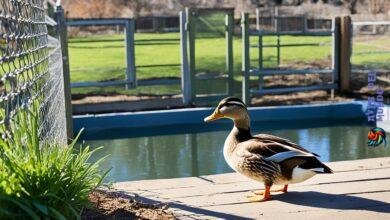The Peking duck is one of the most popular breeds in the United States. Although its place of origin is still disputed by experts, it is believed that this adorable breed of duck comes from some region of Southeast Asia.
In general, this breed of duck is raised for its meat and eggs, however, they are sometimes kept as pets. These ducks were imported to North America in the early 1870s and have since proven to be the most successful variety of table duck.
In addition to being every American’s favorite breed of duck, this breed has many practical uses that make them desirable to many farmers. The Peking duck can produce many eggs and reach a good size perfect for the table. If you are looking for a good dual-purpose breed of duck, the Peking might be ideal for you.
Characteristics of the Peking Duck
This is one of the largest breeds of duck that exist, and as expected one of the most popular for meat production. On average, an adult Peking duck will weigh between 8 and 12 pounds. As with most animals, male ducks will generally grow a little larger than females.

The Peking duck is found in only one variety: white. However, ducklings are yellow at birth, and as Peking ducks grow, the yellow fluff gradually turns into beautiful creamy white feathers: the legs are orange and will remain that way throughout their lives.
The beak of the Peking duck shows an intense yellow color. Some Peking ducks develop some dark spots near the tip of their beak after reaching full maturity.
The body shape of a Peking duck is long, fairly wide and full-breasted, the main reason why this breed is preferred for meat production.
Breed temperament
In addition to their meat and egg-producing qualities, Peking ducks are commonly kept as domestic birds. Ducks, in general, have a strong need to impress their keepers and need a lot of attention in their first weeks of life. Pekingese are known for their good temperament and attachment to their caregivers.
Pekin paws have very little predisposition to mother their own young and have no tendency to become broody. If you are interested in raising Peking breed ducks, you will definitely need to gain experience in incubating duck eggs.
Egg and meat production
About 95% of all duck meat consumed in the US is Peking duck meat. These waterfowl are extremely popular table birds and are a good choice for restaurant owners or small farmers for their significant meat and egg production capacity.
Ducklings grow very quickly and become large, heavy adults very quickly, with feathers fully developed by 6-8 weeks of age. Females would also begin laying eggs within 6 months of birth. An adult bird can produce 8 to 9 pounds (live weight) of good quality meat and 140 to 210 large, white eggs each year.
Diet and nutrition
Both domestic and wild ducks eat a nearly identical diet, if the flock is allowed to free range. Domestic Peking ducks are often given a balanced poultry feed. Ducklings can eat chick starter feed as long as it is not medicated.
Balanced layer food is also an excellent option for adult legs. The percentages of calcium and other essential nutrients in their diet help paws lay better quality eggs and longer-lasting shells. When free, a Peking duck will patrol for tadpoles and small frogs, small fish and crustaceans, algae, berries, worms, nuts, crickets, flies, and especially mosquitoes.
Garden vegetables are also a Peking Duck favorite: you can include lettuce and grapes in their diet as a healthy training treat.
Unlike chickens and other poultry, ducks spend most of their lives outdoors, even on cold, rainy days.
Housing requirements
If you are used to raising chickens, the problem of housing ducks is naturally a little more complicated than that of chickens.
When it comes to houses, it is generally best to keep your home on the ground because ducks can sometimes be fickle when climbing ramps. Inside your home, provide at least 6 square feet per duck. It is not necessary to provide raised nests or perches because your Peking duck will prefer to do all its business on the ground.
Outdoors, provide 12-15 square feet per duck to ensure everyone has enough room to run and stretch their wings. As with all ducks, providing a water source is important for the health and happiness of your webbed friends.
History
In 1872, James E. Palmer of Stonington, Connecticut, decided to bring fifteen white ducks of this breed from China to send to a businessman named McGrath in the United States.
On a 124-day voyage to America, the original 15 ducks were reduced and eventually four ducks became the first breeding birds of the Peking in the United States. After two years of selective breeding, Pekins were accepted into the American Poultry Association in 1874.
Today, the Pekingese is the most widespread duck in the United States, with tens of millions raised for meat production alone. This duck is a decent dual-purpose breed, but its primary use is undoubtedly commercial meat production.
